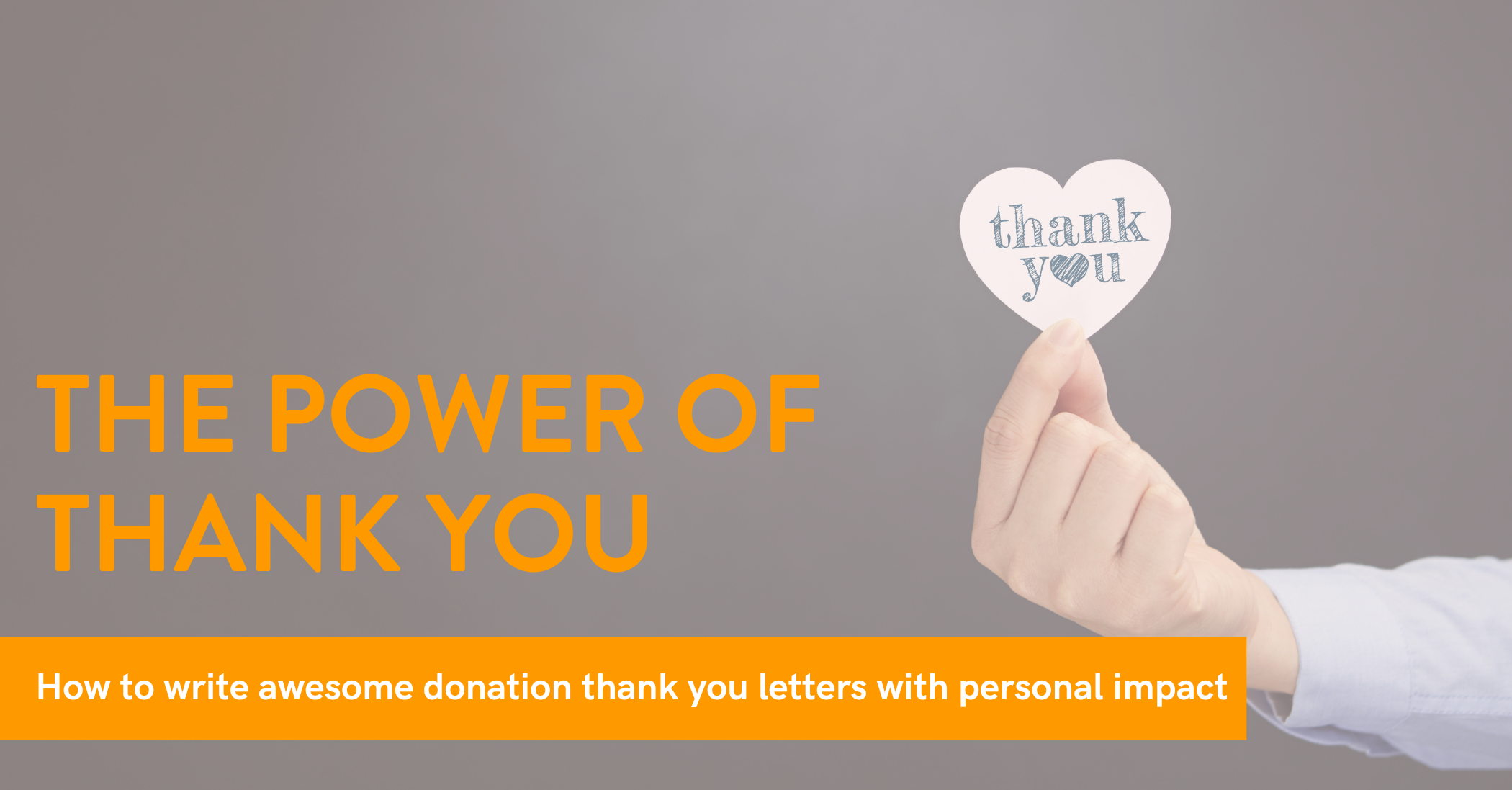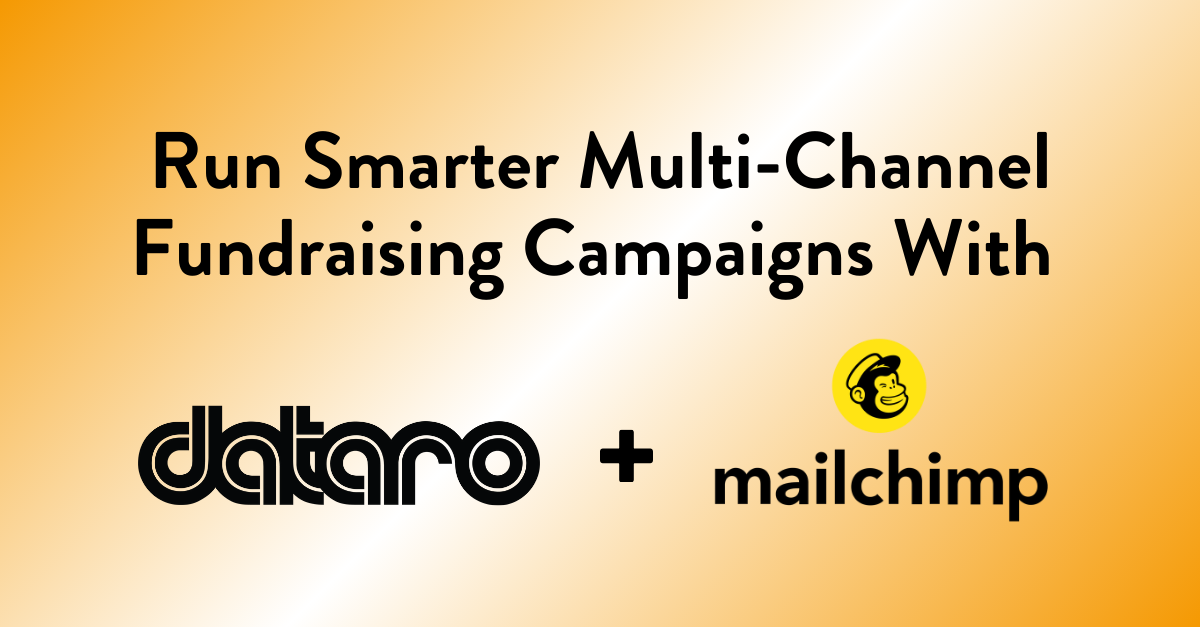
How to Write Awesome Donation Thank You Letters
Katrina –
You work hard to raise funds for your cause. That’s why each new donation brings a rush of satisfaction. But, don’t be tempted to move on to planning the next appeal or fundraising campaign before properly thanking your donors. Writing thoughtful and personalized donation thank you communications can go a long way toward building lasting relationships and encouraging continued support from your donors.
In this blog post, we will explore the significance of saying thank you, the difference between donation acknowledgement letters and tax receipts, why personalization matters in acknowledging donors, plus our top tips for crafting meaningful and personalized thank you communications.
The power of saying “thank you”
Thanking donors effectively is a vital component of good donor stewardship. A well-crafted thank you strategy can have profound impact on your donor retention, engagement and the overall success of your fundraising efforts.
Thank you messages contribute to good donor stewardship because they help:
– show acknowledgement and recognition of a donors’ contribution and the important role they play
– make donors feel appreciated and valued, which builds stronger emotional bonds
– demonstrate impact and educate donors about your work or other ways they can support
– show accountability and demonstrate how funds are being responsibly used
– nurture your donors’ continued commitment to your cause and foster loyalty
By making donors feel valued, understood and connected to your organization’s mission, you’re more likely to foster a community of dedicated supporters who stand with your organization over other worthy causes. An effective thank you can mean the difference between a donor cancelling their monthly gift or continuing to give to your organization over others, especially during times of economic uncertainty.
In a recent Dataro User Group on Improving Monthly Donor Retention (watch on demand here) we shared a feedback from a donor that demonstrates the impact of a well-timed thank you outreach. This quote is from a call centre who spoke with a donor as part of a stewardship thank you calling campaign:
“I just spoke to [Amy] and she made a point of saying that we are the only charity who rang her throughout COVID and thanked her for her generosity and support. [Amy] donates to multiple charities who have all rung her and asked for more money. She said because of that, she has cancelled her support of other charities and continued to support [our charity].“
What’s the difference between a Thank You Letter and Tax Receipt for donations
It is crucial to distinguish between a thank you letter and a tax receipt, as both serve different purposes.
A donor acknowledgement letter or thank you letter is sent by a nonprofit organization to express appreciation to a donor for their generous contribution. Its primary focus is to express appreciation and acknowledging the donor’s contribution to your organization’s mission and serves as a confirmation that the donation was received (and provides important details such as the donation amount and date).
On the other hand, a tax receipt is a document that allows the donor to claim a tax deduction for their donation, although this varies by country. A tax receipt should contain specific information required by the tax authorities. For example, the United States requires written acknowledgments for charitable contributions of $250 or more to include the nonprofit’s name, donation amount, and a statement affirming that the donor did not receive any goods or services in exchange for their contribution.
It is best practice to send a separate, personalized thank you letter in addition to the legally required tax receipt. Thank you letters are a key part of good donor stewardship because they help convey gratitude and if done correctly can give donors confidence that their gift will be used effectively to support the cause they care about.
Why personalize donation thank you letters?
Personalizing donation thank you letters is essential because it shows donors that you genuinely value their support and recognize their individual impact on your organization. A generic, one-size-fits-all thank you letter can feel impersonal and may not resonate with the donor. Personalization conveys that you took the time to understand their specific motivations for giving and that their contribution matters on a personal level.
Personalized thank you letters can also help you build stronger relationships with your donors, increasing the likelihood of their continued engagement and future donations. When donors feel appreciated and connected to your cause, they become more invested in your organization’s success.
Should every donor thank you letter be personalized?
While it may be challenging to personalize every letter, especially for larger nonprofits with a high volume of donors, it’s worth the effort to personalize as many letters as possible. For major donors or those who have consistently supported your organization, personalized letters are a must. For smaller donations, a thoughtful template with personalized elements, such as addressing the donor by name and mentioning their specific impact, can still create a meaningful connection.
Personalization can be time consuming, so you need to work smarter. Segmenting your donors based on their giving potential allows you to prioritize the right supporters for personal touches like adding a handwritten note to the letter. And with new generative AI technologies, you can quickly produce first drafts of donor communications, making it possible to create personalized thank you letter templates for each segment in your campaign.
Remember, every touchpoint with your donors is an opportunity to strengthen the relationship. When you take the time to craft personalized thank you letters, you show donors that their support is genuinely valued.
A fundraiser’s top tips for writing effective thank you letters
When it comes to writing thank you letters, personalization is key. So we asked ex-fundraiser and Dataro Customer Success Manager Goldia Shum for her top tips for writing effective thank you communications with a personal touch.
- Address the donor by name: Always use the donor’s name in the salutation and throughout the letter. Avoid using generic terms like “Dear Supporter” or “Dear Donor.”
- Express gratitude in the opening sentence: Start with a sincere expression of gratitude for the donor’s support. Always use warm, genuine language in line with your brand’s tone of voice.
- Acknowledge the individual gift amount: Mention the specific amount or type of contribution the donor made. This demonstrates attention to detail and reinforces the impact of their gift.
- Mention the specific impact: Describe how the donor’s contribution is already making a difference. Highlight the programs or initiatives their donation will support, illustrating the direct impact of their generosity.
- Tailor messaging for different donor segments: Tailor your thank you letters to different groups based on their interests, history of support or engagement level. This shows you understand who the donor is and how they are making a personal impact.
- Connect to the donor’s motivations: If possible, reference any personal connections the donor may have to your cause or previous involvement. Show that you understand what drives their passion for your organization.
- Encourage ongoing engagement: Express your desire to keep the donor informed about your organization’s work and invite them to get involved in other ways, such as volunteering for the programs they support or attending events.
- Include a handwritten note: Consider adding a handwritten note to the letter, even if it’s just a short sentence. Handwritten elements add a personal touch that can make the donor feel special.
Use AI to quickly write (and personalize) donor thank you letters
Taking the time to craft thoughtful and personalized thank you letters will undoubtedly yield lasting benefits for your nonprofit organization. Using new generative AI technologies like GPT and AI assistants can help save you time in writing the perfect thank you letter and personalizing them at scale.
In the case of Dataro’s new generative AI writing tool AI Assist development professionals can quickly generate first drafts of thank you letters and tailor them to different donor segments with the click of a button.
Unlike ChatGPT, AI Assist is built specifically for nonprofit fundraising use, so the content generated is fundraising-specific and requires less work by the user to produce high quality fundraising communications. As with any generative AI content, always remember to review and fine-tune the generated content to ensure it is accurate, authentic and specific to your cause.
Using Dataro’s AI Assist to generate your first draft thank you letters and to personalize communications to different donor segments will ensure your donors feel valued and recognised in a way that resonates with their individual support and help you build lasting relationships. And save you time and effort, so you can do more fundraising!




